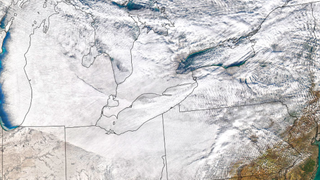Satellite sees deadly blizzard and 'bomb cyclone' blanket the US northeastern in snow (photos)
Satellite imagery from NASA shows snow, ice and clouds blanketing the northeastern U.S. during the peak of the holiday travel season.

A "bomb cyclone" had widespread effect across the United States and Canada.
Fresh satellite imagery shows snow and clouds blanketing the northeastern U.S. states along with Canada's province of Ontario. The treacherous conditions on the ground Saturday (Dec. 24) and Sunday (Dec. 25) included blizzards, thick snow and freezing rain, posing a threat to travelers during the peak holiday season.
"As winds howled and snow piled up from what some forecasters called a 'once-in-a-generation' storm, so did the traffic accidents, power outages, and transportation woes," NASA officials wrote in a statement about the imagery, obtained with the agency's Aqua satellite.
Gusts of wind were recorded as high as 79 mph (127 kph) in Lackawanna, New York, just south of the city of Buffalo. Several other states saw winds blowing at 50 mph (80 km/h), according to National Weather Service statistics quoted by NASA.
Related: 'Bomb cyclone' hits eastern US as satellites watch (video)
This false-color version of the image uses a combination of visible and shortwave infrared light to distinguish clouds (white) from snow and ice (blue). pic.twitter.com/370V5yMgIlDecember 27, 2022
A "bomb cyclone" refers to a sudden drop in pressure of at least 24 millibars in 24 hours. Combined with blizzard conditions, some communities alongside the Great Lakes saw incredible amounts of snow.
Communities east of Lake Ontario and Lake Erie, particularly the Buffalo region, saw a storm surge of more than 50 inches (127 cm), NASA officials noted. Other regions saw less snow reach the ground, however, peaking at only about 5 inches (13 cm).
Get the Space.com Newsletter
Breaking space news, the latest updates on rocket launches, skywatching events and more!
Aqua obtained the imagery using its Moderate Resolution Imaging Spectroradiometer (MODIS). The image leading this article is in natural color, while the Twitter embed focuses on visible and shortwave infrared light to better see the differences between clouds (white) from snow and ice (blue).
Satellites are a key tool in weather forecasting and also in disaster response, where relevant. NASA and the National Oceanic and Atmospheric Administration (NOAA) have a large fleet gazing at the planet, and have pledged to launch more in the 2020s to refresh some of the older ones. Aqua, for example, launched in 2002.
Elizabeth Howell is the co-author of "Why Am I Taller?" (ECW Press, 2022; with Canadian astronaut Dave Williams), a book about space medicine. Follow her on Twitter @howellspace. Follow us on Twitter @Spacedotcom or Facebook.
Join our Space Forums to keep talking space on the latest missions, night sky and more! And if you have a news tip, correction or comment, let us know at: community@space.com.

Elizabeth Howell (she/her), Ph.D., is a staff writer in the spaceflight channel since 2022 covering diversity, education and gaming as well. She was contributing writer for Space.com for 10 years before joining full-time. Elizabeth's reporting includes multiple exclusives with the White House and Office of the Vice-President of the United States, an exclusive conversation with aspiring space tourist (and NSYNC bassist) Lance Bass, speaking several times with the International Space Station, witnessing five human spaceflight launches on two continents, flying parabolic, working inside a spacesuit, and participating in a simulated Mars mission. Her latest book, "Why Am I Taller?", is co-written with astronaut Dave Williams. Elizabeth holds a Ph.D. and M.Sc. in Space Studies from the University of North Dakota, a Bachelor of Journalism from Canada's Carleton University and a Bachelor of History from Canada's Athabasca University. Elizabeth is also a post-secondary instructor in communications and science at several institutions since 2015; her experience includes developing and teaching an astronomy course at Canada's Algonquin College (with Indigenous content as well) to more than 1,000 students since 2020. Elizabeth first got interested in space after watching the movie Apollo 13 in 1996, and still wants to be an astronaut someday. Mastodon: https://qoto.org/@howellspace
